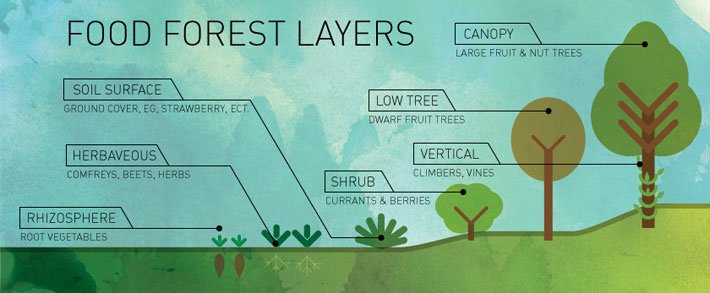Translating Intent to Impact
Intent is what you envision, impact is the outcome of your actions.
Photo of Dunbar Spring roundabout - credit Brad Lancaster and HarvestingRainwater.com
Fun Fact about myself, I’m a tree-planting nerd. I’ve planted well over 200 trees in the last 4 years in our yard and across our community. I broadly enjoy gardening but have a borderline rabid fixation on establishing a self-sustaining food forest.
In case you’re unfamiliar with the concept, a food forest consists of different layers of plants (check out the picture below) working together to create an ecosystem that generates food while regenerating itself. Local to us, one of the most impressive food forests is the Dunbar Springs neighborhood, located in Tucson, which has a neighborhood-scale food forest. And the whole thing is watered using water harvesting (rainwater, street runoff, etc) - it’s impressive (to learn more Click Here). Fanboy musings aside, the goal of creating a food forest is incredibly broad and can be fraught with distractions.
Image credit Aubrey Yee via SustainableAmerica.org
In our last blog, we talked about goal setting using the SMART model (Specific, Measurable, Achievable, Relevant, Time-Bound) to mitigate distractions. We’re going to spend a little bit more time on the Specificity component this time around. In the context of my food forest goal, it is incredibly easy to see a desirable plant and immediately jump to “I should plant that.” Yes, it is in line with the overarching goal. It gives immediate project satisfaction from ticking several tasks off the list (dig hole, plant, water, etc.). But it may not be in line with the desired impact at this point in time.
Think about a project plan you’ve worked on. Anything from a massive software development project, to building a piece of Ikea furniture. Have you ever done a step out of order? Worked on the right thing at the wrong time? Just yesterday, I baked bread and added some ingredients out of order. In some instances, it works out alright and the ordering doesn’t cause a negative impact - bread came out fine. But in other instances the ordering, while it may not be obvious, is critical. In the case of my food forest, planting the right plant at the wrong time can lead to the plant dying or struggling - a waste of resources.
It can be helpful to take a beat, and really consider the Intended Impact of a project/initiative. There are a lot of proverbs about intent, go ahead and pick your favorite. Breaking it down:
Intent is what you envision in your mind as your goal.
Impact is the result, the reality, of your actions.
Adding the small extra step of thinking through your Intended Impact - or what you envision the outcome of your actions being - can help you prioritize efforts and organize your thoughts/project.
I intend to make a food forest.
To actually net that outcome, I need to plant things in an order that helps to set the ecosystem up properly (e.g., I need to plant/build
things to address the strong winds before planting fragile things).
Being intentional about what you are sowing today will yield bountiful results in the future.
Until next time!


